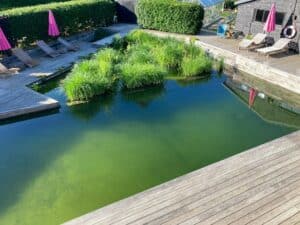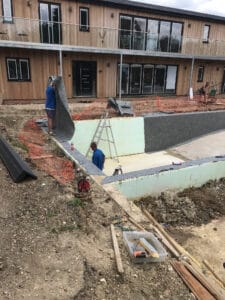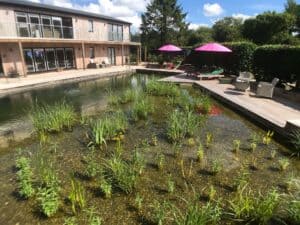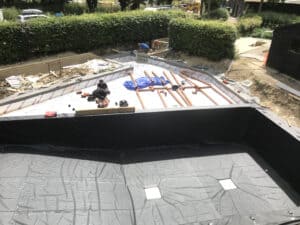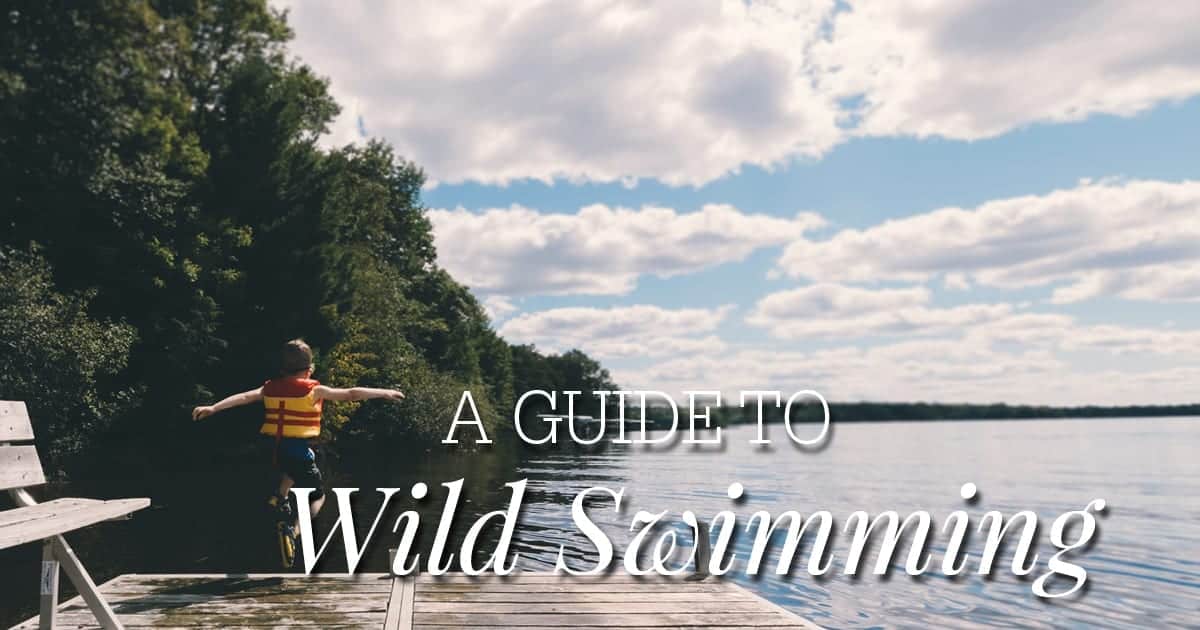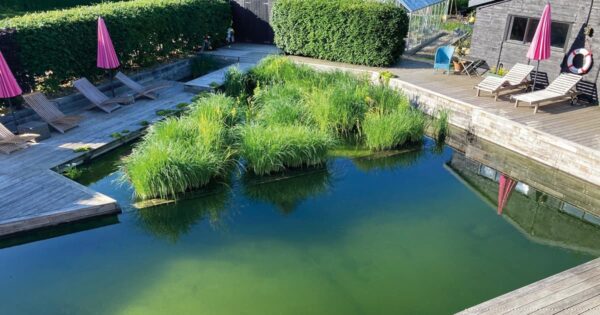
Natural pools, or natural swimming ponds, are increasingly on trend. Despite the initial construction costs, they not only improve your guest experience, but they are also better for the environment. We caught up with Max Parker at Piglets Boutique B&B to understand the basics of installing and maintaining a natural pool, as well as why they are a better choice than a regular swimming pool.
Last month it was reported that a number of swimming pools would be closing for the summer.
The Independent reported that a national chlorine shortage combined with rising energy costs forced public swimming pools in several parts of the UK to temporarily close or offer reduced services.
A survey by UKActive also found that 85% of public pool operators would be “forced to reduce services in the next six months”.
This brought to mind a new trend for swimming facilities which may be of interest to you.
If you’ve ever considered installing a pool, or maybe you want to revamp the one you already have, why not consider a natural pool?
We spoke to Max Parker, owner of Piglets Boutique B&B in Wimbish, to learn all about the process of installing a natural swimming pond at their property.
What is a natural swimming pool…?
“A natural pool, or natural swimming pond, is a swimming pool that is filtered and purified biologically by water plants and a special biological filtration system. Natural ponds can be any shape, size or style and designed to blend with your garden.”
– Ellicar, specialists in natural pools and ecological landscapes
Why did you choose to build a natural pool rather than a regular swimming pool?
Max: Having swum in a natural pool, I would be reluctant to go back to a regular swimming pool. There’s no chlorine or other chemicals that smell or leave your eyes stinging and being in totally clean, natural water is such a different experience.
Swimming surrounded by nature, with the plant’s bacteria working all the time to keep the pool crystal clear, adds to one’s sense of mental well-being.
And with the current trend of cold water therapy, many guests who swim in the sea say it is almost ‘tropical’, whilst those who are not so brave will swim a length and then become acclimatised and addicted.
What do you need to start building a natural pool?
Max: An expert. There are a number of companies offering their design and building services for natural swimming ponds.
We investigated a number of companies but one kept cropping up, who were branded a ‘fixer’ for problem ponds, so that’s who we used to oversee the project, with our local general builder doing the heavy work.
“There’s no chlorine or other chemicals.”
I’d also say that once you start building it, insulate it. We chose to heavily insulate ours with a special polystyrene liner filled with concrete, then covered that in felt before the top liner went in.
This was originally done so that the pool could be heated if we wanted, but guests prefer the cold water therapy an unheated pond provides. (It can reach 25 degrees in the summer months, but many guests still like to brave the water even in January!)
How much would it cost to build a natural pool?
Max: With the surrounding decking etc, I’d say it could cost anything between £125,000 and £150,000 for a good size pond.
Cost Guide, Natural Pool:
The cost of a natural pool will depend on the size and shape that you choose to go with as well as the level of associated garden design. It will also depend on the company or ‘experts’ you choose to work with to create your natural pool.
Some fees to expect include:
- Consultation Fee
- Design Fee
- Construction
The average starting price for a natural swimming pool or pond is approximately £125,000 but there are other companies who can create smaller pools for a smaller price tag.
For example, at Swim Ponds by Michael Wheat, prices can start from £60,000.
Ellicar charges approximately £60,000 for constructing an earth shaped pond of 100sqm and £85,000 for a concrete constructed natural pool of 100sqm.
According to The Swimming Pond Company, you can expect their costs to start around £75,000 for an 80sqm pond.
However, these prices are usually the starting point, only covering the construction.
Remember you need to think about extra costs that might need to be added on such as topographical surveys, design fees, garden design, decking and more.
Cost Guide, Traditional Swimming Pool:
According to Sallie Leslie-Golding at the Swimming Pool and Allied Trades Association (SPATA), the cost of a traditional swimming pool can also vary. It depends on the geographical location and the type of traditional pool you choose.
Sallie explained that costs can start from hundreds of pounds for the most basic paddling pool to approximately £15,000 for a top of the range above-ground pool kit. A liner pool would be an average of £50,000, while a fully-tiled, reinforced concrete outdoor pool would be in the region of £80,000.
Larger projects (especially indoor pools requiring heating and ventilation) will range in cost from £100,000 to £200,000+ (not including the cost of the pool hall).
Sallie also explained that finding the right installer is extremely important.
SPATA recommends choosing an experienced and reputable contractor who can help you through the entire installation process and who can also offer advice on:
• All types of heating, (and ventilation where applicable)
• Safety protection devices
• Water hygiene management
If you are considering a traditional pool, SPATA is a good place to start as it sets the swimming pool industry standards. Companies who join SPATA agree to follow the SPATA Standards and abide by the SPATA Code of Ethics. Members of SPATA can also provide detailed information on their products, with backup from their respective manufacturers.
For info on pool maintenance click here
How do you choose the shape and size?
Max: You need to consider what space you have available. If it’s just for general fun, then I would go for a funky, more natural-looking pond shape with a big regeneration zone, which lends itself to a more natural feel and could be located in a field or similar.
However, if you want to entice swimmers, then a pond like ours would work.
We have a rectangular swim zone and our pool is 14.55m x 5.45m. It’s 2m at the deep end and 1.3m at the shallow end, which allows for guests who want to do lengths and also dive in. But it also means that those who aren’t as confident or not so proficient can put their feet down until halfway.
Can you explain a little bit about how your natural pool works?
Max: Basically, the water (originally from the mains) is pumped through a series of perforated pipes which lie embedded in gravel in what is called the regeneration zone. This is only about one foot deep and it’s where all the plants are planted, right next to the swim-zone which is plant free.
The water circulates through the regeneration zone and then through a series of filters to remove any phosphates and other elements, allowing the plants’ own bacteria to balance the bacteria in the water.
The water becomes crystal clear, but 6 weeks before we opened I was getting nervous because the pond was an opaque green colour.
But I was assured this wouldn’t last and literally overnight, the balance of bacteria in the pond changed and I was suddenly greeted, much to my relief, with a beautiful, clear pond ready for our guests.
Once it’s built, what sort of maintenance has to be carried out on a natural pool?
Max: Minimal. Once the bacteria balance has got to the point where the plants take over and the water is crystal clear, you may only end up having to occasionally remove leaves during autumn from nearby trees.
Then if there’s a heat wave, you sometimes need to do the occasional top-up from the tap due to evaporation during sunny weather.
The water doesn’t need to be drained away every winter like in a normal swimming pool.
The other thing is, if a pump goes down during the summer months, pond weed will quickly start to appear which can take a while to remove with natural treatments. But that’s only if there’s a malfunction.
Are there any rules/regulations you need to follow if you have one of these built?
Max: We’re an adults only B&B and we don’t open to the general public, only residents (despite weekly requests to ‘come and swim’). Therefore, the need to have a lifeguard is not required.
However, of course we have a life buoy and a list of rules that we ask the guests to follow, such as no running or jumping and no glass around the pond (we provide plastic glasses for this area). But that’s just general health and safety.
What are the advantages and disadvantages of having a natural pool?
Max: I cannot think of any disadvantages over a regular pool, except for perhaps construction costs, but these are balanced by the need for no chemicals and minimal maintenance.
Also on the plus side, you’re not left with an empty blue pit in the garden during the winter. You can still enjoy a year-round ‘live’ experience as nature goes through its changes.
The pool becomes a mecca for pond life, from frogs to newts, water boatmen, dragonflies and of course plant growth.
Many guests ask if there are fish in the pond, but no. Fish and ducks are a complete no-no for a natural swimming pond as their poo will mess with the clarity of the pond, the bacteria balance and all the good work the plants are doing.
As nice as it might be to be able to swim with koi carp or see a mother Mallard with her chicks swimming past, it won’t be so nice to swim in after a while. Our two rescue dogs who are Beagle Bassets keep the ducks off for us!
There are also great health benefits and it’s a great pull for guests who like natural, open water swimming.
And also for us, it bolts onto our wellbeing theme in conjunction with our sauna, gym, general relaxation areas and outdoor and indoor games.
Max’s Top Tips
1. When guests find out you have a natural swimming pool, they will want to check in early so they have more time to use it. Make sure you are firm on your rules.
2. Provide guests with towels and offer to dry the towels for them. Otherwise they’ll get left lying around and will soak the beds and other pieces of furniture.
3. Be prepared for interruptions in your daily routine. Having a pool means people may want to spend more time on site so you may be busier and have less time to do your daily tasks and errands.
4. Being adult-only is a godsend if you have a pool. If there were little ones running around or older kids being noisy and unruly, you would probably have to employ a lifeguard and the ‘zen’ feel for guests would be severely disrupted.
5. Ensure no glass is allowed in or around the pool. Draining it would be a massive job and it would take months to get the pond back to usability as the plants would need time to perform their magic all over again. Invest in some polycarbonate glassware and even though this might be more expensive than regular plastic glasses, they will last longer, feel better in the hand and they are also dishwasher safe.
Different types of pools:
There are a number of pool options available if you’re not settled on a natural swimming pond… (source ellicar.co.uk)
Natural Pool
A natural pool has a swimming area and regeneration zones, separated by low submerged walls. The regeneration zones are home to beautiful water plants which filter and purify the water naturally, keeping it hygienically clean and crystal clear.
Hybrid Pool
A hybrid pool combines the filtration technology of a living pool with the beauty of water plants. You can enjoy the ecological benefits of a natural pool but with more space for swimming and less space for the regeneration zones.
Hybrid pools can be heard, usually with an air source heat pump so you can use it from May – October.
Living Pool
Looking just like a conventional pool and without water plants, a living pool is chemical-free so you can enjoy swimming in pure, living water. The water is purified and filtered hygienically. During the swimming season, a pool robot cleans the pool daily. They can be heated up to 28C, usually with an air source heat pump. Ellicar advises covering an outdoor living pool when not in use.
Swimming Pond
Built from excavated, earth shaped walls, without the need for concrete, swimming ponds provide an area for swimming surrounded by beautiful water plants that purify and filter the water naturally.
URLs
piglets.co.uk/2021/01/05/a-money-pit/
swimponds.co.uk | pondandgardendesign.co.uk

